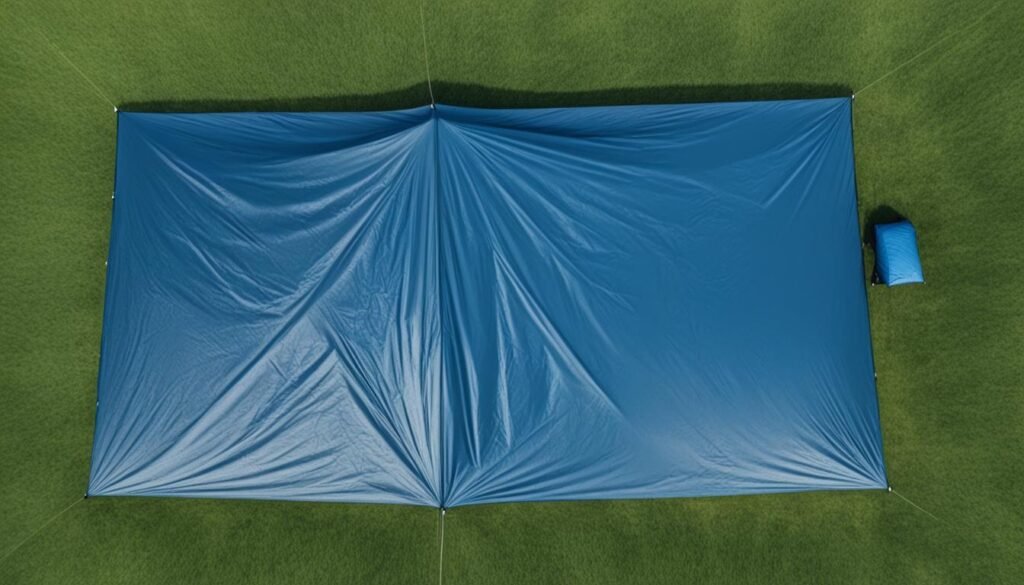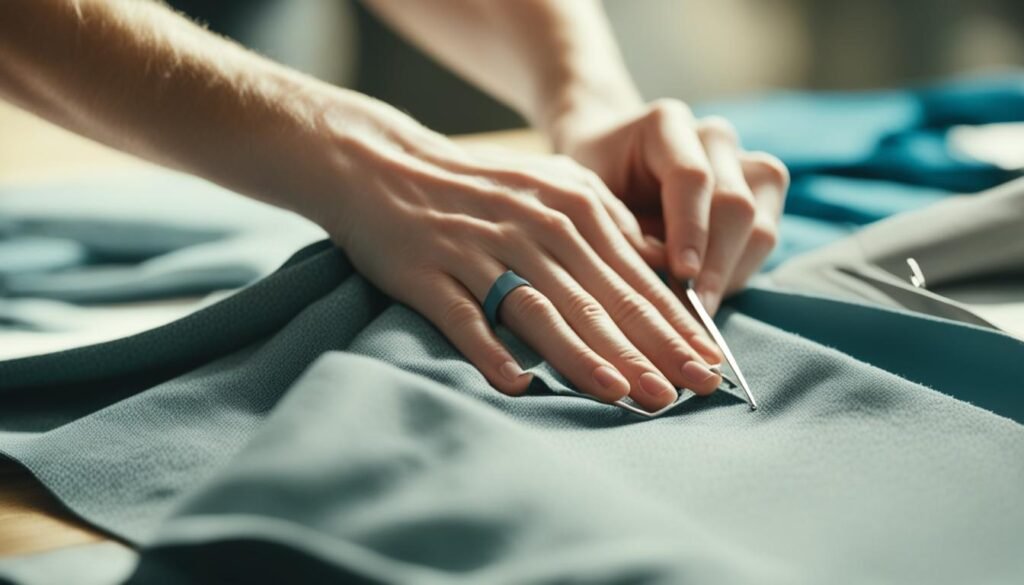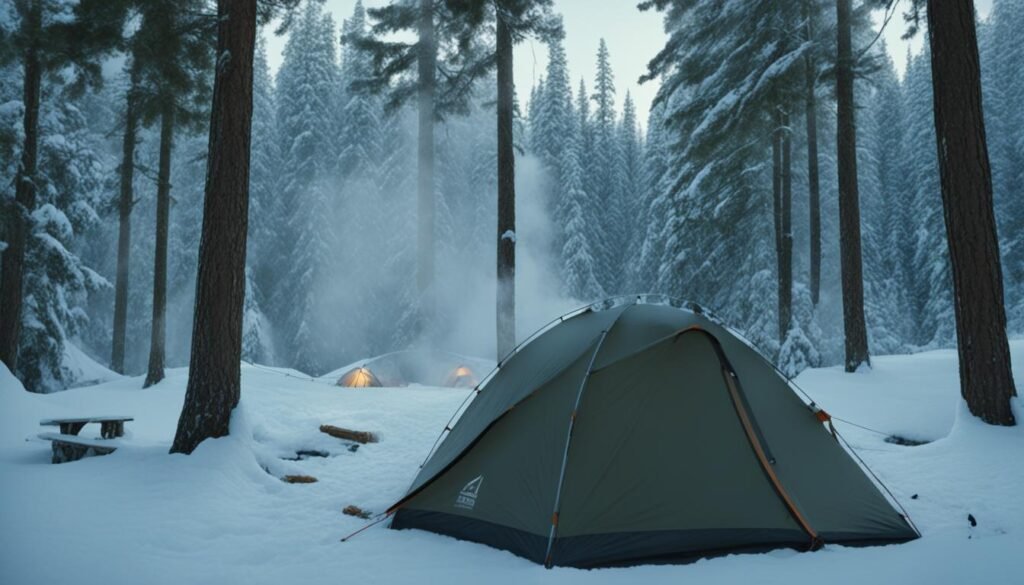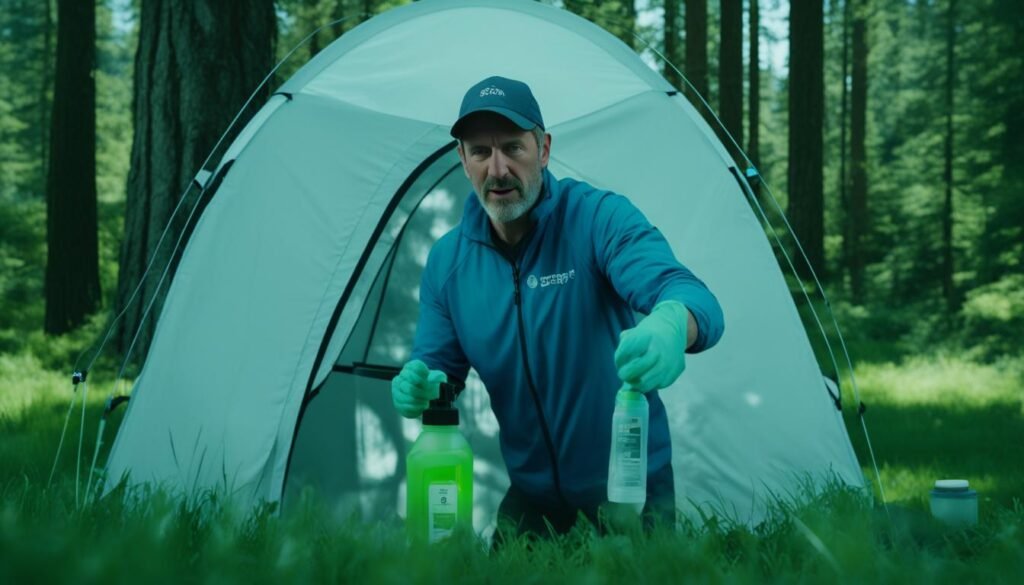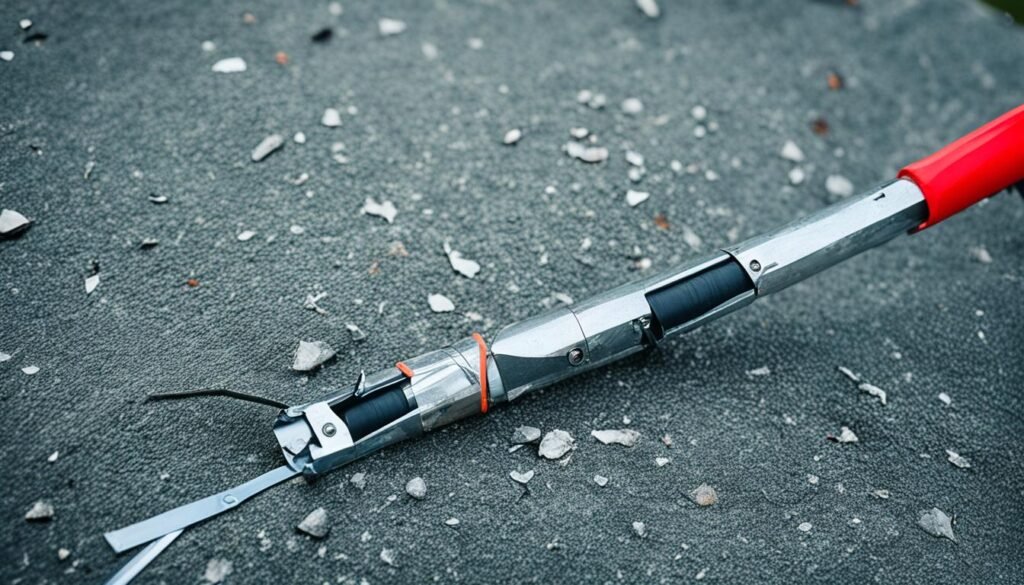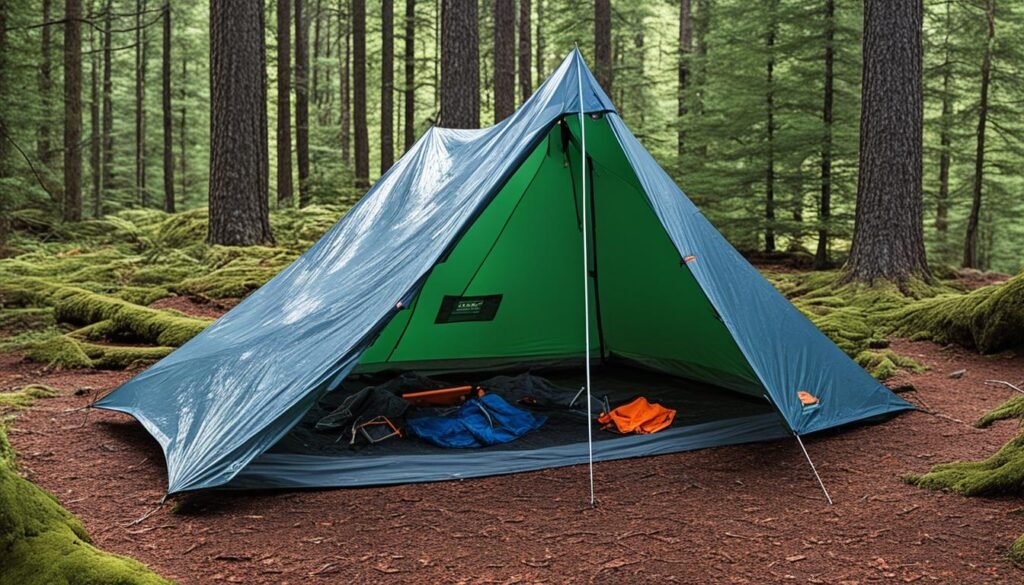The choice of best tent materials is vital for a tent’s performance. The right outdoor tent fabric can make your tent last longer. It also keeps you safe from different weather conditions. When picking suitable tent fabrics, look at flame retardant, UV resistance, and fabric strength. Think about fabric weight and how well it lets light through, too. Doing this helps your tent meet your needs and last a long time.
Let’s Go Aero’s ArcHaus and Moon Unit Tailgate Shelter are top-notch. They are better than most 4-season tents. They have an 185D rating, which is really strong. Plus, Moon Unit has a 50UV rating for great UV protection. And a 2,000 PU rating means they keep you dry in heavy rain. Most big tent brands use polyester, which dries fast and is light even when soaked. This adds to tent material durability.
Most tents come from Asia. This is because Asia is great at making lightweight fabrics and skilled in sewing. Working with these experts can help you choose the best fabric for your outdoor fun. This way, you make the most of your tent.

The Importance of High-Quality Tent Fabrics
Choosing the right tent fabric is crucial for any event. You need top-quality tent fabrics to make your tent strong and reliable. These materials, when used with strong poles, can handle wind and rain. They make sure your guests stay safe and dry. When you invest in a tent made from the best materials, it will last a long time. This brings peace of mind to those planning the events.
Today’s tents are made from different heavy-duty tent materials for specific purposes. Here are a few examples:
- Laminated vinyl fabrics with a 1000 denier rating are the highest available at American Tent, offering exceptional strength and durability.
- 16 oz. PVC vinyl fabric provides strong and dependable protection against the elements.
- UV resistant fabrics help prevent fading and weakening, extending the lifespan of tents.
- Polyester tents, fit for camping, might not be tough enough for big events but are great for fun.
- Canvas tents are kind to the earth but not as strong against weather as newer materials.
- Nylon tents are light and good for hiking, yet may not last long for commercial-grade tents.
For commercial-grade tents, critical features include denier count, thread count, and fabric weight. Higher denier means a stronger fabric. Thread and GSM numbers tell you how thick and durable the fabric is. Imagine a 150D polyester fabric is tougher than a 75D one. Tent weights range typically from 280gsm to 380gsm.
On top of that, fabrics can get special treatments like silicone, Polyurethane (PU), and SIL/PU coatings. These make tents waterproof, stronger against tears, and more breathable. They’re used from small hiking tents to heavy-duty tent materials for big events.
Flame Retardancy in Tent Fabrics
Choosing tent fabrics with flame retardancy is key. It keeps you safe and follows rules, lowering fire risks outdoors. Fire-resistant materials keep campers and gear safe from fire.
A study by Duke University and REI found chemicals in some camping tents were risky. As a result, REI removed these dangers. Their tents, meeting safety standards, are safer and show their care.
REI and others in the OIA are working for better safety in tents. They think the current safety standard, CPAI-84, needs to be updated. New standards are needed for safer camping today.
Tent fabrics should meet NFPA 701-2 standards. Flame retardants on fabrics can be harmful. Try to reduce contact and stay safe by washing hands after setup.
REI is looking to change how tents are made. They hope to let brands choose if they use flame retardants. This could lead to safer, more flexible options.
Buying tents with fire-resistant materials is smart. They are safe and give peace of mind. Tents from places like American Tent are durable and follow strict safety rules. Check your local fire safety laws to be sure your tent is safe.
Understanding UV Resistance
UV resistance is a key factor in keeping tents looking good and strong. Nylon and polyester are mainly used in tents since the 1970s. Polyester is popular for top-quality tents because it fights UV rays better. This leads to better protection for outdoor tents.
Too much UV light can harm tent fabrics by breaking down their parts. This damage makes them weaker over time. After being in the sun for 100 days, many fabrics are more than half as strong as they were. They often become weaker than 70% of their original strength.
When fabrics are sun-damaged, colors fade, whites turn yellow, and they get discolored. Buying a UV resistant tent fabric can stop this. It helps your tent last longer, especially in the sun a lot.
Experts have some good advice on this topic. Linc Aldershof says coated tent materials are usually better than laminated ones. They might cost more but last longer. This is important for people who rent out tents or use them a lot. Jeff Sparks mentions that coated fabrics work better in very cold weather. This shows it’s worth it to choose high-quality materials.
Rob Jones talks about three important things for fabric strength: trapezoidal tear strength, grab strength, and puncture resistance. Making sure your tent fabric stands up to these tests can really help. It makes your tent last longer.
John Kardos says that taking good care of your tent is crucial. Following what the manufacturer says to do can help a UV resistant tent fabric live a long life. Storing it clean and dry is a must.
Looking for fabrics that are strong against UV, mildew, water, and fire is very smart. These features help keep your tents safe and last for a long time. Choosing the right fabric is the first step to a long-lived tent.
What is Denier in Tent Fabrics?
The term “denier” tells us about tent fabric’s strength and how thick it is. Denier (D) shows us the weight and size of the threads in the fabric. If a fabric has a higher denier number, the threads are thicker. This makes the fabric stronger. For example, 40D Nylon is stronger than 15D Nylon. Also, 150D Polyester is tougher than 75D Polyester.
Fabric denier can be as low as 50 or as high as 500 for tent materials. Lighter tents have lower denier numbers. Knowing the denier rating helps you understand how strong a tent material is. For very tough materials, like heavy-duty vinyl, you might see higher denier numbers. This makes them good for use in hard weather or for a long time.
Polyester tents are usually better at keeping water out than nylon. This is because they are made of fibers that are close together and are plastic. But remember, nylon and polyester tents can be thick and strong in different ways. For extreme use, tents made from 1000 denier laminated vinyl, like those from American Tent, are a great choice. They are very durable.
Fabric Weight and Durability
Fabric weight is a big deal when picking a tent. It’s measured in ounces for every square yard. The right weight can make your tent last longer and perform better. Tents made of 16 oz. PVC vinyl are very strong. They keep you safe in tough weather, which is great for families.
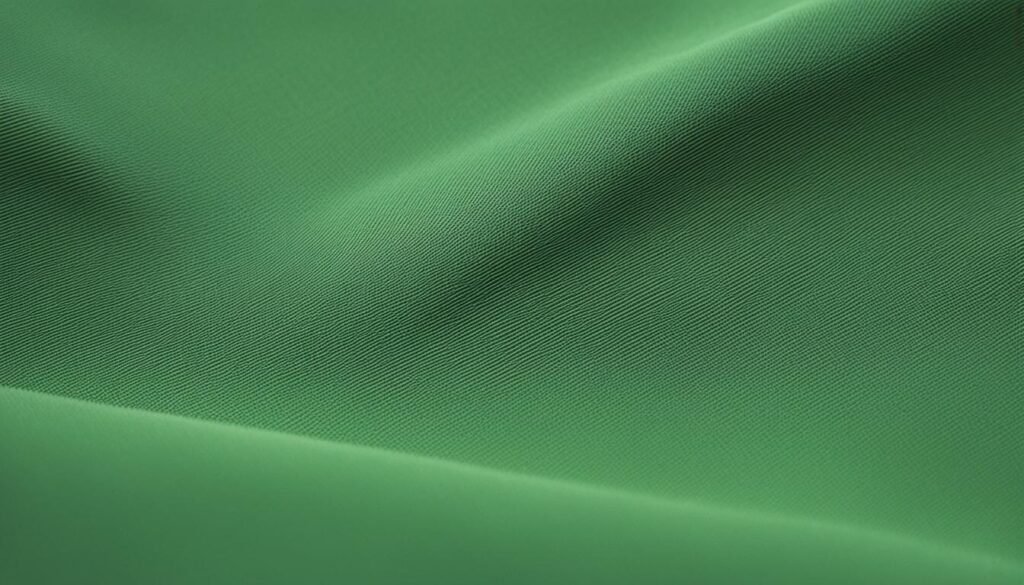
Nylon is a top pick for light tents. It’s strong but light, perfect for backpacking. Tents made with ripstop nylon are harder to tear. This means they last longer. Polyester is good if you need something strong against the sun and moisture. Even though it’s heavier, the durability justifies its weight for most campers.
Translucency of Tent Fabrics
How much light a *tent fabric brightness* lets through changes the feel of any gathering. Translucent materials make the place feel bright and inviting. They are great for events wanting to use natural light to boost the experience.
*Shade-providing tents* use fabrics that block out most light. This creates a cozy area that’s cooler. Special materials like silicone and polyurethane help these fabrics block the sun’s heat.
- Nylon fabrics can absorb up to 10-15% of their tensile strength when wet, causing noticeable sagging and weakness.
- Polyester is better, only absorbing tenths of a percent of water. This keeps the tent strong even when wet.
- For a balance of durability and weight, 20D ripstop polyester works well. It keeps the tent bright and strong.
- Silicone coatings improve tent fabrics. They make the tent lighter and better at providing shade.
Choosing the right *tent fabric brightness* and how much light it lets through is key. It helps set the perfect mood. A clear tent top that uses *light-permeable materials* can make your event stand out.
Country of Origin and Its Importance
When you buy a tent, where it’s from can really matter. Tents made in America are known for being top-notch. They last long and are very strong. This is because they are carefully made to meet the highest quality standards.
American tent fabrics are trusted even by the U.S. Department of Defense. They demand the best tents that can handle tough conditions. The fabric used in these tents is the finest, perfect for any use.
For thousands of years, Native Americans and Aboriginal Canadians used strong fabrics for their teepees. These structures were great at keeping out wind, rain, and snow. They set a high bar for tent fabric quality that we still follow today.
Today, we depend on tents for many different needs. They’re used for fun camping, helping in disasters, and even to give shelter to those without homes. States like California rely on well-made tents. By choosing American fabrics, we get tents that can handle any situation. They keep people safe and comfortable.
- Quality and Durability: American-made tent fabrics are made to last with strict quality checks.
- Historical Significance: The strong tradition of making durable tents started with Native American tribes.
- Modern Application: Tents are needed for various uses today, making their origin very important.
Choosing American fabrics for your tent means choosing quality. It’s about picking materials that are reliable in all situations. Always look at where the tent is made to ensure you’re getting a quality product.
Hydrostatic Head Explained
The hydrostatic head (HH) rating shows how much water tent materials can withstand. The higher the HH value, the more water the tent’s material can resist. This is key for keeping tents dry in any weather.
For the test, brand new materials are used. They shouldn’t be creased, folded, or soaked already. Keep in mind, high HH ratings don’t always mean the floor of the tent is super tough over time. It also doesn’t tell us how much water gets through or how the material might get weaker with lots of use.
Fabric’s weight and strength, how much it can stretch, and its weave all matter. Tear and wear often influence how durable waterproof materials are. Though HH tests are easy, using different ways to check materials might give us more info.
Today’s materials, especially those with silicon coatings, often do better in HH tests than old materials. Yet, the way water tension happens in these tests might not be like real rain. This could change how well a tent can keep you dry when you’re out there.
The usual HH number for tents is 3000mm. This works well for places like the UK with regular rain. But, in very wet or snowy areas, it’s good to have a tent that can handle more water. That’s why some tents have HH values between 5000mm and 10000mm. Tents for dry lands usually need an HH over 1000mm.
The groundsheet might have a higher HH rating because it touches wet earth all the time. Methods like the Water Column and Schmerber tests measure how well a fabric holds up to water. They show the HH in millimeters.
HH ratings are important for picking waterproof outdoor gear, especially tents. But, the tent’s build, sealed seams, and added covers also really help keep water out. Adding things like seam sealers, tarps, and more coatings can make your tent even better at staying dry inside.
To sum up, HH ratings help us choose the right gear for staying dry outside, based on where and how we’ll use it.
Types of Tent Fabrics: An Overview
There are many tent fabrics to pick from. Each one is good for different things. Knowing about these fabrics helps you choose for your outdoor fun.
Polyester Tent Fabric: Polyester is tough and doesn’t wear easily. It’s perfect for bad weather. It keeps UV rays off you, so it’s great for being outside a lot. The kind with more denier and thread counts, like 70D, lasts longest.
Nylon Tents: Nylon is light but super strong, even more than polyester. It usually has ripstop to stop tears from getting bigger. These are best if you want strength without a heavy tent. Just be ready to re-coat them in lots of sun.
Laminated Vinyl: Vinyl has a layer that nothing can get through, making it really waterproof. It can handle up to 10,000mm of water. But remember, it’s heavier and can cost more.
DCF Tents: DCF is super light and tough. It keeps water out really well. Even though it costs more, it’s a top pick for lightweight and durable tents.
Choose a tent by looking at things like the denier and thread counts, plus how waterproof it is. Don’t forget about special coatings for more protection. This way, your tent will be just right for your trips.
Laminated Vinyl Tents: Pros and Cons
Laminated vinyl is great for tents because it lasts long and keeps you dry. It’s known for being heavier, which helps it resist tearing and block UV rays well. This makes it good for many uses.

This type of vinyl is really strong against bad weather. It looks shiny and keeps out the sun’s harmful rays. But, because it’s heavy and not very flexible, it can be hard to carry and set up.
American Tent likes using laminated vinyl for its tents. It’s safe near fires and very sturdy. This means it stays in place well, even in tough conditions. Also, it’s a good choice for both personal and business tents because it does its job well without costing too much.
However, you need to think about the good and bad sides of using this vinyl. While it’s great at protecting you and lasting a long time, it is heavy. This might not be good for people who need a tent they can easily move around or set up differently. It’s crucial to think about what you need and choose the best material for your situation.
- Pros: Enhanced durability, UV protection, abrasion resistance, weather and fire resistance
- Cons: Heavier weight, less flexibility
At the end, choosing waterproof laminated vinyl can protect your tent from rough weather and last a long time. By thinking about what matters most, you can find the right material for your tent that also fits your budget.
Polyester Tents: Durability and Cost
Polyester tents are loved for their toughness and long life. The big plus with these tents is they don’t soak up much water. This means they don’t stretch out when it rains, unlike nylon. Polyester keeps its shape, making your tent more steady.
Folks who know a lot about tents often choose polyester. It’s stronger against tears and keeps its size better than nylon. Plus, it fights off the sun’s rays, rain, and wind, lasting longer. This is why affordable polyester tents are a hit with outdoor folks.
Even though polyester tents are usually heavier, they’re pretty light. This is great for people who hike or backpack light. Also, they dry out and are lighter when wet, which is a big help when the weather turns bad.
Now, tents which cost about $200 are often made of 68D or 75D polyester. These are great because they are not too pricey and last a long time. While they may be a bit a little more costly than nylon, their toughness is often worth it. Polyester also fights off mold, making the tent last even longer.
To sum up, whether you camp just on weekends or a lot, UV-resistant polyester tents are perfect. They stand up to all kinds of weather. So, choosing a top-notch polyester tent lets you enjoy the outdoors safely and comfortably.
Canvas Tents: Eco-Friendly but Heavy
Canvas tents are known for being kind to the environment. This is because they are made from a natural material. Even though there are lighter options available, eco-friendly campers prefer canvas.
Cotton canvas tents are not as common as polyester and nylon ones. But, they have some good points. They keep noise out and keep you safe from the weather.
Canvas tents beat synthetic ones in how they let air through, scoring 1-0. They also keep heat out better, scoring 2-0. Canvas is best at keeping rain away (3-0), lasting a long time (4-0), letting air move freely (5-0), being strong (6-0), and stopping the sun (7-0).
However, there are some downsides too. Canvas tents are heavy and hard to carry. Plastic tents are not as good in some ways but are much easier to move around.
Even with these problems, canvas tents have big pluses. They help the planet and work very well. This makes them a great choice for people who like to camp and care about the earth.
Understanding Tent Fabrics: What Works Best for You?
Choosing the right tent fabric is key for a good time outside. Many tents have fabrics from 40D to 75D. But, Let’s Go Aero’s ArcHaus and Moon unite with a 185D fabric. This is very thick, making these tents super strong and protective.
It’s also crucial for tents to protect you from the sun. The Moon Unit tent shines with a 50UV rating. This means it’s really good at keeping you safe from the sun’s rays.
How well a tent keeps you dry comes down to its PU rating, from 500mm to 10,000mm. Most 4-season tents are around 1,500mm. Yet, Let’s Go Aero’s Moon Unit and ArcHaus have a 2,000 PU rating. This keeps you dry even when it pours.
Another key point is how heavy and how quickly a tent dries. Polyester, like in the MoonLight tents, soaks up less water than nylon. When it comes to weight and drying, polyester is better. That’s why many choose it for camping.
Mid-range tents often use 68D and 75D polyester fabrics for a good balance. Nylon, on the other hand, can become heavy and cause moisture. This makes polyester the preferred choice for keeping dry and comfortable, especially for those who love the outdoors.
Nylon Tents: Lightweight and Strong
Nylon tents are loved for being light and tough. They became popular over 50 years ago because they are strong and tear-resistant. Even though polyester has gotten stronger, many still choose nylon for its history and proven use.
Nylon is great because it can be used in many ways. Nyloon is good for portable tents, perfect for backpacking. Different types of nylon, like Nylon 6 and Nylon 6.6, are very strong. Nylon 6.6 is especially strong and lasts well in tough weather.
But, nylon has its issues too. It can take in water and get weaker by 15%. And, when wet, it might sag, losing space inside. To solve this, some nylon tents have a silicone coating. This makes them more waterproof and stops them from sagging as much.
Fabric density, known as denier, matters in nylon tents. Lightweight nylons with low denier, like 20D, are good for a mix of light weight and strength. Ripstop patterns make these tents more sturdy, lasting even if they get small tears.
Knowing about nylon’s pros and cons is key if you’re looking for a new tent. Nylon tents are a great choice for outdoor lovers because they are light and strong. Nylon’s use in tents keeps growing, thanks to new technology. This makes nylon a top pick for tents because of its known quality.
Polypropylene Tents: An Eco-Friendly Choice
Polypropylene fabric is great for eco-conscious campers. It mixes being green with being tough. It uses materials that can be recycled, making it good for the planet. Plus, these tents are strong and last a long time.
Polypropylene is also fire-resistant. This means the tents are safer without needing harmful chemicals. This is really important because many chemical products can be bad for people and the planet.
Big brands like Big Agnes and NEMO are making tents that are free from toxic stuff. They use materials like cotton, hemp, and recycled polyester. These choices show they care about nature and making good, safe tents. Polypropylene shows the way forward for making tents. It’s about being smart with nature and keeping us and the Earth safe.

